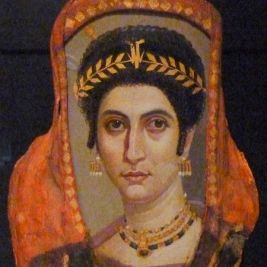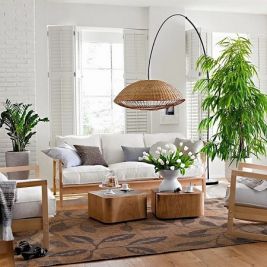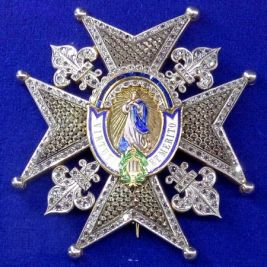
The most famous Russian artists who worked from the 17th to the 20th century
Russian artists are highly esteemed worldwide, as evidenced by the popularity of "Russian seasons" at leading Western auctions. Choosing the best among numerous accomplished painters is not easy. However, there are masters who have made a particularly significant contribution to the development of Russian culture and world art. Let's remember famous Russian artists who are considered the best of the best.
 Famous Russian artists. Ilya Repin. Reply of the Zaporozhian Cossacks, 1891
Famous Russian artists. Ilya Repin. Reply of the Zaporozhian Cossacks, 1891
Simon Ushakov
Simon Ushakov (Russian: Симон Ушаков) is one of the most renowned artists of the 17th century. He came from a noble family and received art education from an early age. At the age of 22, he was appointed as an honorary iconographer at the royal court, a distinction usually reserved for experienced masters. The young artist worked in the Silver and Golden Chambers, gained experience by participating in the decoration of the Moscow Kremlin, and even painted a portrait of Tsar Alexei Mikhailovich. Later, Simon Ushakov began to work in the Armory Chamber, which was the center of artistic life in Russia at that time. He quickly became the most respected master and formed his own school of icon painters.
Researchers consider Simon Ushakov a bridge between old and new art. He developed the ancient Russian icon painting traditions while reforming the genre by giving the holy figures depth and realism. The artist urged his students to make icons as reflections of the real world and wrote a treatise for them, which became one of the earliest works on painting theory in Russia.
One of Simon Ushakov's finest works is the icon "Praise of the Vladimir Icon of the Mother of God," also known as the "Tree of the Russian State." It depicts the image of the Mother of God of Vladimir and twenty Moscow saints. The icon "Archangel Michael Defeating the Devil" is interesting because it supposedly features the artist himself as a little man on the left side of the angel. There are approximately 50 known icons by Ushakov.
 Famous Russian artists. Simon Ushakov. Archangel Michael Defeating the devil, 1676
Famous Russian artists. Simon Ushakov. Archangel Michael Defeating the devil, 1676
Fyodor Rokotov
Fyodor Rokotov (Russian: Фёдор Рокотов) is the most renowned Moscow portraitist of the 18th century. He painted members of the imperial family and entire family galleries of the nobility. This artist was said to have "copied" the whole of Moscow. Before Rokotov, the fashion was for cold and formal portraits, but he created soft and natural images in warm tones. The subjects of Rokotov's paintings seem familiar with the artist and feel at ease posing for him. Only in his later period did his portraits become more ceremonial, in line with the neoclassical style.
 Famous Russian artists. Fyodor Rokotov. Coronation portrait of Catherine II, 1763
In the 19th century, Fyodor Rokotov's works were almost unknown to anyone. The Tretyakov Gallery housed only one portrait of Grigory Orlov (Russian: Григорий Орлов) painted by him, while the rest of his works hung in noble mansions. He was remembered in the early 20th century, in part thanks to an exhibition organized by Sergei Diaghilev (Russian: Сергей Дягилев) and the nationalization of private collections. The most famous work of this master is "Portrait of Alexandra Petrovna Struyskaya." Many are familiar with the poems by Nikolay Zabolotsky (Russian: Николай Заболоцкий) dedicated to this image.
Famous Russian artists. Fyodor Rokotov. Coronation portrait of Catherine II, 1763
In the 19th century, Fyodor Rokotov's works were almost unknown to anyone. The Tretyakov Gallery housed only one portrait of Grigory Orlov (Russian: Григорий Орлов) painted by him, while the rest of his works hung in noble mansions. He was remembered in the early 20th century, in part thanks to an exhibition organized by Sergei Diaghilev (Russian: Сергей Дягилев) and the nationalization of private collections. The most famous work of this master is "Portrait of Alexandra Petrovna Struyskaya." Many are familiar with the poems by Nikolay Zabolotsky (Russian: Николай Заболоцкий) dedicated to this image.
 Famous Russian artists. Fyodor Rokotov. Portrait of Alexandra Petrovna Struyskaya, 1772
Famous Russian artists. Fyodor Rokotov. Portrait of Alexandra Petrovna Struyskaya, 1772
Ilya Repin
Ilya Repin (Russian: Илья Репин) is the greatest Russian realist artist who shared the philosophical ideas of Vissarion Belinsky (Russian: Виссарион Белинский) and Nikolay Chernyshevsky (Russian: Николай Чернышевский). He himself stated that he couldn't create flattering paintings but aimed to convey the truth of the surrounding life on canvas. Repin painted portraits of outstanding contemporaries, especially Lev Tolstoy (Russian: Лев Толстой), addressed political themes, depicted rural life, and didn't refuse official commissions from the emperor. His body of work is often referred to as an encyclopedia of post-reform Russia.
 Famous Russian artists. Ilya Repin. Self-portrait, 1878
Famous Russian artists. Ilya Repin. Self-portrait, 1878
 Famous Russian artists. Ilya Repin. Barge Haulers on the Volga, 1873
Famous Russian artists. Ilya Repin. Barge Haulers on the Volga, 1873
Many of Ilya Repin's works have become so deeply ingrained in our mentality that they are surrounded by legends and live their own lives. Controversies still continue around the painting "Ivan the Terrible and His Son Ivan." It was banned from public display immediately after its creation, was vandalized with a knife in 1913, and a century later, in 2018, history repeated itself. Currently, the damaged canvas is undergoing restoration. Other famous works by Repin include "Barge Haulers on the Volga" and "Reply of the Zaporozhian Cossacks."
 Famous Russian artists. Ilya Repin. Ivan the Terrible and His Son Ivan, 1885
Famous Russian artists. Ilya Repin. Ivan the Terrible and His Son Ivan, 1885
Isaac Levitan
Isaac Levitan (Russian: Исаак Левитан) is considered the finest Russian landscape painter who managed to capture the "soul" of our nature. Even at a young age, as a student of Alexei Savrasov (Russian: Алексей Саврасов) and Vasily Polenov (Russian: Василий Поленов), he demonstrated brilliant talent. He aroused the displeasure of many respected painters because a young Jewish man was painting authentically Russian landscapes and outperforming "native artists." Isaac Levitan was a member of the Peredvizhniki (Russian: Передвижники) society and taught at the Moscow School of Painting, Sculpture, and Architecture, exerting significant influence on his students.
 Famous Russian artists. Isaac Levitan. Self-portrait, 1880
Famous Russian artists. Isaac Levitan. Self-portrait, 1880
 Famous Russian artists. Isaac Levitan. Above Eternal Rest, 1894
Famous Russian artists. Isaac Levitan. Above Eternal Rest, 1894
Levitan's landscape "Above Eternal Rest" is called the most Russian of all paintings. In this philosophical work, the fragile and ephemeral human life is juxtaposed with the grandeur of eternal nature, creating an atmosphere of profound melancholy. Other works that have become the artist's hallmark are dedicated to the seasons. These are "March" and "Golden Autumn." Both landscapes are akin to Impressionism because they are painted with special attention to light and color. The artist aimed to convey not so much the objective reality as the impression of nature—either awakening or blazing with color before fading.
 Famous Russian artists. Isaac Levitan. March, 1895
Famous Russian artists. Isaac Levitan. March, 1895
 Famous Russian artists. Isaac Levitan. Golden Autumn, 1895
Famous Russian artists. Isaac Levitan. Golden Autumn, 1895
Valentin Serov
Valentin Serov (Russian: Валентин Серов) (1865-1911) gained fame as the finest Russian portraitist of the 19th century and was considered the epitome of moral behavior. This artist's work served as a transitional link between the traditions of realism and the new art of the turn of the century. This master worked deliberately, and not every model had the patience to endure all the sittings. Serov had an unusual method: he first achieved maximum likeness in his portraits and then made the subject appear older than their actual age but incredibly accurately conveyed their character and inner world.
 Famous Russian artists. Valentin Serov. Self-portrait, 1880s
Famous Russian artists. Valentin Serov. Self-portrait, 1880s
Even if Valentin Serov had created only one work, "A Girl with Peaches," he would have still engraved his name in the history of painting forever. The portrait depicts the daughter of the philanthropist Savva Mamontov (Russian: Савва Мамонтов), in whose estate the artist stayed for a long time. While working on this painting, he aimed to capture an atmosphere of freshness and liveliness that couldn't be found in the finished works of realists. The task was successfully accomplished, and the portrait brought the author well-deserved fame. The image of Vera Mamontova (Russian: Вера Мамонтова) is considered one of the best depictions of carefree and happy childhood.
 Famous Russian artists. Valentin Serov. A Girl with Peaches, 1887
Famous Russian artists. Valentin Serov. A Girl with Peaches, 1887
Kazimir Malevich
Kazimir Malevich (Russian: Казимир Малевич) is a symbol of the Russian avant-garde, and his name is known far beyond Russia. He is the founder of a new type of abstract painting. Other artists were gradually moving towards abstraction, simplifying and transforming nature, while Malevich completely rejected it. He began creating works that portrayed nothing from the surrounding reality but existed on their own.
The legendary "Black Square" became the starting point and "icon" of this new direction. Writer Tatiana Tolstaya (Russian: Татьяна Толстая) called this work an unbridgeable gap between old and new art, and critic Nikolai Punin (Russian: Николай Пунин) wrote that the author was "a projectile sent by the human spirit into the pure desert of intuition."
 Famous Russian artists. Kazimir Malevich. Self-portrait, 1933
Famous Russian artists. Kazimir Malevich. Self-portrait, 1933
The direction created by Malevich is known as Suprematism. This non-objective art is based on simple geometric shapes of different colors and sizes arranged on the canvas according to the laws of statics and dynamics. The background is always white, symbolizing infinite space. One of Malevich's works, "Suprematist Composition," was sold at Sotheby's for 60 million dollars.
The ideas of Suprematism persisted even in the face of the persecution of avant-garde painting and manifested in other fields such as architecture and design.
 Famous Russian artists. Kazimir Malevich. Black Square, 1915
Famous Russian artists. Kazimir Malevich. Black Square, 1915
Kuzma Petrov-Vodkin
Kuzma Petrov-Vodkin (Russian: Кузьма Петров-Водкин) is considered the most revolutionary artist - for the time when he created his brilliant masterpieces, for the chosen subjects, and for the innovative style of his paintings. His works astonished with their boldness and unique style, eliciting diametrically opposed assessments from critics. He drew inspiration from the aesthetics of Orthodox icons. The Red Horse, which seems strange to contemporaries, was borrowed from an ancient Novgorod image of Saint George.
 Famous Russian artists. Kuzma Petrov-Vodkin. Self-portrait, 1918
Famous Russian artists. Kuzma Petrov-Vodkin. Self-portrait, 1918
 Famous Russian artists. Kuzma Petrov-Vodkin. Bathing a red horse, 1912
Famous Russian artists. Kuzma Petrov-Vodkin. Bathing a red horse, 1912
Following the traditions of icon painting, Petrov-Vodkin experimented with perspective, giving the images an "otherworldly" appearance. The spherical perspective transforms the wounded commissar into a dying saint, and the soldier behind him into an angel receiving the soul. Simple herring and other everyday objects in Petrov-Vodkin's still lifes look as if they are from another world, which is why the author is sometimes called the Russian Cézanne. The still lifes of this painter are highly sought after at international auctions.
 Famous Russian artists. Kuzma Petrov-Vodkin. Death of a Commissar, 1928
Famous Russian artists. Kuzma Petrov-Vodkin. Death of a Commissar, 1928
 Famous Russian artists. Kuzma Petrov-Vodkin. Herring, 1918
Famous Russian artists. Kuzma Petrov-Vodkin. Herring, 1918
Lovers of classical art should pay attention to the auctions that regularly take place on the online platform Very Important Lot. This is an excellent opportunity to add a unique work of art to your collection, created in Russia or other countries. You can also purchase a painting, sculpture, icon, or jewelry from a promising contemporary artist at an affordable price, who will become just as famous over time.


 François Boucher - the frivolous artist of the French king: biography and best paintings
François Boucher - the frivolous artist of the French king: biography and best paintings  Fayum mummy portraits - ritual painting that preceded its time
Fayum mummy portraits - ritual painting that preceded its time  Japandi style in interior design - a minimalist fusion of East and West
Japandi style in interior design - a minimalist fusion of East and West  The Timeless Charm of Vintage Ephemera: A Collector's Guide
The Timeless Charm of Vintage Ephemera: A Collector's Guide  The painting "Menshikov in Berezovo" by Vasily Surikov is a dramatic depiction of the life of the disgraced prince
The painting "Menshikov in Berezovo" by Vasily Surikov is a dramatic depiction of the life of the disgraced prince  Current Popular Items in the Antique Market
Current Popular Items in the Antique Market  Realism - the art of portraying life in all its manifestations truthfully
Realism - the art of portraying life in all its manifestations truthfully  Order of Carlos III is the highest civilian award in Spain
Order of Carlos III is the highest civilian award in Spain  Online auction at HERMANN HISTORICA 8-13 July 2024: Kunst, Antiquitäten & Antiken
Online auction at HERMANN HISTORICA 8-13 July 2024: Kunst, Antiquitäten & Antiken  Art: its essence, types, genres, and history
Art: its essence, types, genres, and history